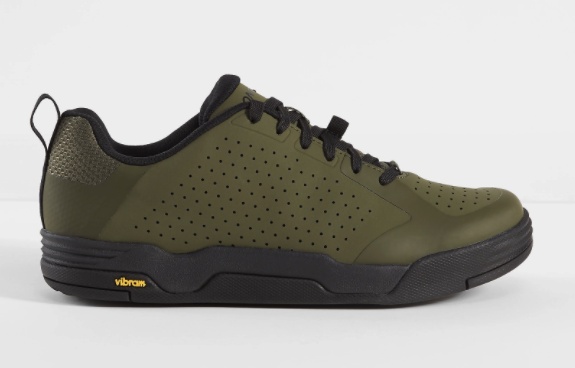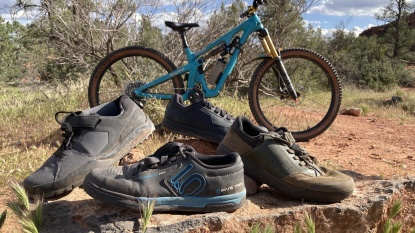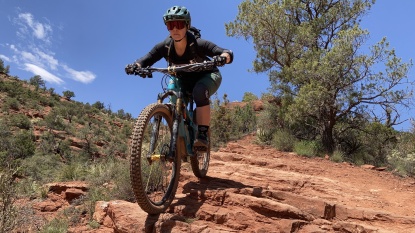Bontrager Flatline - Unisex Review
Our Verdict
Our Analysis and Test Results
The Bontrager Flatline falls short in a field of flat pedal mountain bike shoes that becomes more and more competitive each year. The shoe is lightweight and breathable, making it a great choice for warm weather riding, but the Vibram sole lacks the grip found in other models and the EVA midsole does not have the best power transfer. Given the price point and lack of grip, we recommend looking at similarly priced models that perform better.
Performance Comparison
Grip
Bontrager utilizes Vibram rubber on the sole of the Flatline with a uniform square grid pattern extending from just above the ball of the foot towards the heel. We tried a variety of pedals in combination with the Flatline and found the shoe's grip to be lacking in comparison to other models in our test. Unlike shoes whose tread pattern has recesses for the pedal pins to sink into there is little room between the squares on the sole making it harder for the pins to sink into the shoe's sole.
At the toe and the heel, Bontrager uses a directional tread pattern for increased traction during hike-a-bikes. The Flatline is comfortable for hiking and provides good traction on slabs, but on loose scree and kitty litter requires a more assertive foot placement as one would expect from a non-lugged sole.
The Flatline's Vibram rubber sole feels relatively firm to the touch in comparison to other shoes in our test. While riding, our feet feel like they are sitting on top of the pedal pins instead of the pins settling in the shoe's sole. Because of the lack of grip the Flatline earns lower marks in this metric.
Comfort and Protection
The Flatline earns high marks for its breathability and comfort but does not quite stack up to the competition when it comes to protection, placing it in the middle of the pack in this metric.
The Flatline is light on the foot, breathable, and comfortable. It features a padded tongue and Bontrager's inForm Performance last which is listed as their roomiest fit. The Flatline is a unisex shoe and its rounded toe box neither feels tight nor sloppy and is comfortable for all-day wear. However, those with a narrow foot may find the fit a bit wide and may want to consider other shoes in our test. There is some additional padding surrounding the ankle that provides some protection, but not a substantial amount.
There is a thin layer of reinforcement at the front of the toebox on the Flatline, but it is not nearly as rigid as other models that use TPU. We can easily compress the front of the Flatline's toebox into its footbed with our thumb. While this may not be a concern for all riders, we prefer a tad more protection in the toe box against rock strikes.
Rigidity and Power Transfer
The Flatline has an EVA reinforced midsole and is one of the softer midsoles in our testing, meaning the rider can feel more of the pedal underfoot. The shoe flexes quite easily from the most forward lace through the toebox during a flex test and is comfortable to walk in. On the bike, the midsole is neither overly stiff, nor overly soft, and you can feel the pedal underfoot but not too much.
The EVA midsole does a good job of dissipating forces from smoother trails, but on rocky trails, we were able to feel more of the trail underfoot. This was especially pronounced when descending chunky trails with medium to large-sized rocks. When standing up and putting power into the pedals on climbs, especially on cross-country trails, the power transfer was not as good as stiffer soled shoes in our test, especially those with less flex through the forefoot.
Breathability
The Flatline's synthetic uppers are very breathable thanks to perforations that extend from the toe box through the midfoot. We wore the Flatline in temperatures from the mid-50s to the low-80s and noted that our feet never felt hot, even in direct sunlight at over 5,000 feet, making it a great choice for warm days and earning them high marks for this metric.
We should note that all those perforations allow water to freely flow into the shoe, one one test ride with a few stream crossings, our feet were instantly wet.
Durability
The Flatline's synthetic upper is holding up well in our testing and shows little signs of wear. There are no rips and no signs of the upper becoming unbonded from the sole. The shoe's Vibram sole is also holding up well to a variety of pedal pins and does not have scarring on the sole.
An elastic lace retainer is built into the tongue and is easy to find thanks to a little pull tab at the top. However, the laces on our size US 7 shoe were very long and need to be double knotted to keep them out of our chain and pedal pins. We would prefer to see a lace length more appropriate for the size of the shoe. Overall the Flatline scores well in this metric.
Weight
At 615-grams per pair for a size US 7, the Flatline is one of the lighter shoes in our test and feels light on the foot. The shoe is easy to spin on the pedals and the low weight makes it a good choice for all-day wear on the bike.
Value
With so many high-performing shoes on the market at a similar price point, we feel the Bontrager Flatline misses the mark in too many metrics to make it a good value. Though, if you prefer a shoe that offers more foot mobility and is highly breathable, they may be a good option.
Conclusion
The Bontrager Flatline has great breathability, something our testers appreciate living in a desert environment. But, the lack of grip and soft midsole is a poor combination when riding technical trails and powering up climbs. Overall, we feel there are shoes on the market that offer better grip, a stiffer midsole, and similar breathability at the same price.











